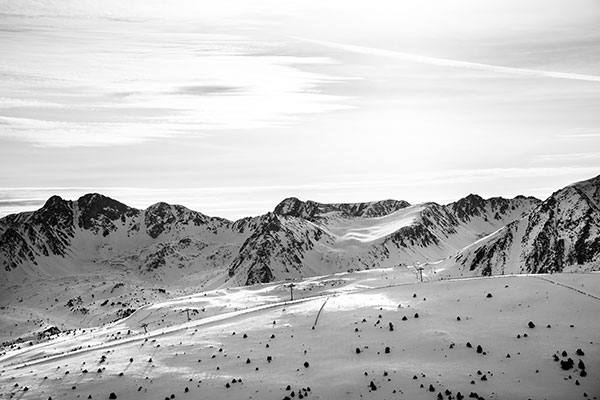
Ski slope colours
When you’re setting off for a day of adventure at a ski resort, you’ll come across various different colours of ski slopes as you explore the snow. But, what are the different levels of ski slopes and what do the colours on ski slopes mean? Well, these refer to the gradient and difficulty levels of the different types of ski slopes, so it’s important to make sure you understand the ski slope grading colours before you try a particular section of piste.

Ski run colours guide
Fortunately, it’s very simple and easy to learn the ski slope colour guide. In this breakdown of the ski slope colours, we’ll outline the differences between green, blue, red and black slopes, so that you can ski or snowboard safely.
One important thing to point out, though, is that different countries and different mountain ranges can have different ski slope colours. For skiing in Andorra, the ski slope colours’ meanings are as follows.
Green ski slopes: Beginner
Any slope in Andorra that has a green marking has been specifically designed for beginners, so this is where you should spend your first hours of learning to ski or snowboard in Andorra. On such slopes, the inclination is very slight, almost flat for the most part. Not only do these slopes have a gradient that is well below 25%, but they also tend to be wider and shallower, offering rookies even more space to take those first skiing steps.
How easy is a green ski slope for beginners?
A green ski slope should be no problem for beginners. Of course, starting a new sport or skill is always challenging, but the green ski slopes are precisely the place to make those inevitable mistakes and to do so in a safe environment.
Blue ski runs: Intermediate
The second easiest of the ski slope colours is blue. This is still a relatively easy type of ski slope, but one that you probably won’t want to try until you’ve had a few lessons or days of skiing under your belt. In fact, on most ski resorts in Europe, you won’t even be allowed to try a blue ski slope until you’ve proven yourself on green. Therefore, the answer to the question of whether beginners can use the blue ski slopes of Andorra is quite clear.
Of course, you may still consider yourself as a beginner even after having practiced on a green slope. But, if you have learned how to brake and how to turn, then you should be ready for the blue slopes, where the gradient should still be less than 25%. With the ski slopes of Grandvalira, this resort is knowing for having some of the very best blue ski slopes in the whole of the Pyrenees, boasting beautiful scenic views of the mountain range and the towns below.
Can beginners use blue ski slopes?
As explained above, the blue slopes are still very safe for newcomers and for beginners. Therefore, beginners, in the sense of this being your first skiing holiday, can use the blue ski slopes. But, many ski resorts will not let beginners try the blue slopes until they have first had a run on the green slopes, even if they just spend an hour or two on green before graduating up the ski slope colours guide.
Red ski slopes: Advanced
Once you get to the red part of the ski slope grading colours, we’re talking about more advanced skiers. This means people who have been skiing for a few years or who have done an express course to get up to speed.
As well as the colours of ski slopes, you can usually also tell which slope you’re approaching based on how busy or not they are. With red ski slopes, you’ll already notice that there are far fewer skiers than with the green and blue ones.
On red ski slopes, it still won’t exceed 40% gradient, but it will often be close to that. As well as the increased steepness of pistes further along the ski slope grading colours, you’ll also notice that these slopes are narrower, leaving less margin for error. So, all the benefits mentioned above about the wider and shallower pistes are reversed when you get to the red ski slopes level. That, though, is exactly what many thrill seekers are looking for.
How steep is a red ski run?
Typically, a red ski run will not exceed a gradient of 40%. In most European ski resorts, the most common red slope gradient is between 35% and 40%. But, at this level, it’s about more than just the steepness, as these runs often have turns and jumps built in too.
Black ski runs: Expert
Going by the Andorran ski slope grading colours, black is the most complicated type of piste by far. That’s not surprising, given that black usually serves as a warning in these kinds of contexts. The black ski runs are, therefore, only for the most expert and professional skiers, with Grandvalira’s Àliga piste even hosting pro events, such as the parallel team event of the 2023 Alpine Ski World Cup Finals.
Is black the most difficult level of ski slope in Andorra?
Yes, in a European country like Andorra the most difficult level of ski slope is black. It’s not impossible to reach that level, but you’ll have to gradually work your way up the ski slope colours scale from green to blue to red and then to black.
